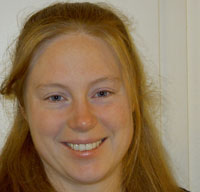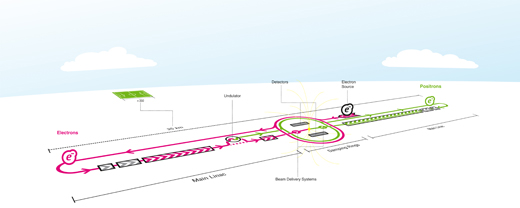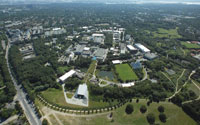Making dark matter a little brighter Inspire article
Jenny List, a young particle physicist working at DESY in Germany, leads her own research group to find out how the Universe works. She talks to Barbara Warmbein.

Image courtesy of DESY
“I’ve always wanted to understand how everything works – from the extremely small to the amazingly big.” As a physicist with a PhD and the leader of a small group of undergraduate and graduate students, Jenny List is well on the way to doing just that.
Her special topic is dark matter, “a bit of a fashionable subject these days”, she smiles, but no wonder: scientists believe that finding and studying dark matter will confirm answers to many questions in physics that were previously only suggested by theory. After all, dark matter makes up 22% of the Universe. Dark energy, a concept even less well understood than dark matter, is believed to amount to as much as 74%, and all the stars and matter in the Universe make up a mere 4%.
Jenny is 32 years old and works at the German particle physics research laboratory DESY (for Deutsches Elektronen-Synchrotron)w1. DESY has its own 6 km particle-smasher, but Jenny is a researcher for a machine of the future, the planned 30 km electron-positron accelerator International Linear Collider (ILC). “We hope that the ILC will not only find the particles that we think make up dark matter, but also let us examine them closely. This is crucially important for our understanding of the Universe,” she says.

Image courtesy of DESY
The ILC will work hand in hand with the Large Hadron Collider (LHC) that is scheduled to start running at CERNw2 in Geneva this year. Thousands of accelerator and particle physicists around the world – including a very active group at the German laboratory – are busy designing the new linear machine and its detectors to make sure that it will reach all the superlatives required in energy, data production and precision measurement.

Image courtesy of DESY
The German school system lets students choose two main subjects for their final two years of school. Jenny, who was born in Hamburg, originally wanted to study mathematics as one of these, but wasn’t happy about the designated teacher. So she chose physics instead. “I have never regretted this decision. My teacher was great, and physics is such a varied subject!” She went on to study it at Hamburg University and had a hard time deciding which of the many different fields she wanted to concentrate on: cosmology? Theory? Astrophysics? In the end, she opted for particle physics, where scientists use enormous and incredibly precise machines to study the elementary particles and the forces that work between them. Jenny worked on the OPALw3 experiment at CERN and finished her PhD there in 2000. As this was the same year that CERN’s big accelerator shut down and no experiments were producing data, she returned to Hamburg for a post-doc position at DESY.
“This was the first time I had to work with polarisation, one of the main subjects of my study group today,” she recalls. When scientists bring two particle beams to collision, they need to know exactly what these beams look like so they can determine exactly what they recorded in the detector. One aspect of those beams is polarisation, a characteristic that shows how many of the particles spin in the same direction. The ILC will use beams of electrons and their anti-particles, positrons. These normally shoot through 15 km of accelerating cavities and radio-frequency fields until they reach the collision point, but at certain points along their track, observation teams like Jenny’s shoot at the beams with a laser.
This isn’t ‘Gotcha!’ for particle physicists but an important exercise to study the properties and behaviour of the particle beams. After the shoot-out, the resulting particles are sent through little gas-filled tubes with mirrors on the inside. Flying through the tubes, they emit a blue light – Cherenkov radiation – which is directed to the end of the tube by the internal mirrored surface. A photodetector measures the amount of light that comes through and the time it takes to get there. “This way we know our electrons very precisely,” summarises Jenny. “The problem is: our polarimeter needs to have double the precision of anything that exists today. We’re basing our design on the best one that exists (at the Stanford Linear Accelerator Centerw4 in California) and trying to find ways to improve it and make it more precise.”

Hamburg, Germany
Image courtesy of DESY
After two positions at different universities in Germany, Jenny returned once again to DESY. She had successfully applied for a scholarship from the Emmy Noether Programme co-ordinated by the German Research Foundation (DFG)w5. It fosters young researchers, giving them independence and managerial experience at an early stage of their scientific career by setting up independent junior research groups.
The scholarships run for five years, and by recruiting them back from abroad, the DFG hopes to encourage outstanding young scientists to stay in the country to continue their university careers. Jenny’s group consists of one post-doc, one PhD and two graduate students. Together they are setting up a device to test their polarimetry tool and writing computer programmes to simulate dark-matter events in ILC detectors.
Apart from running her group, doing research and teaching at university, Jenny also has a busy social life. She loves to ski, sings in a choir, plays the piano and the guitar, and collects anything to do with elephants. “I just like them,” she says. Her husband is also a physicist working at DESY. Jenny explains: “We used to commute between Geneva, Hamburg, Wuppertal and Zurich for years, which was quite exhausting. But being married to a fellow scientist has a lot of advantages: we know each other’s workload, we can go to conferences together and we have a lot of freedom and flexibility in planning our time.” They will surely be taking advantage of this flexibility this year: they have just had their first child.
Web References
- w1 – DESY is the German particle physics research laboratory.
- w2 – CERN is the world’s largest particle physics laboratory.
- w3 – The OPAL experiment, which involved studying particles and their interactions by collecting and analysing electron-positron collision events, was one of the major particle physics experiments at CERN.
- w4 – Stanford Linear Accelerator Center
- w5 – The German Research Foundation, DFG
Resources
- More about dark matter is available from Wikipedia.
- To find out more about the International Linear Collider and its research goals, see: www.linearcollider.org
Institutions
Review
What can you do if you study physics at school? Jenny’s story shows that it is possible to reach exciting levels – such as working at CERN and running your own research group while relatively young – and still have time for family and other interests.
This story of career progression can only inspire potential physicists, perhaps girls in particular. It would make a good hand-out for students who are considering physics as a final subject at school or as a print-out displayed on a careers notice board or science lab – perhaps along with information on other role models in the sciences.
Sue Howarth, UK





